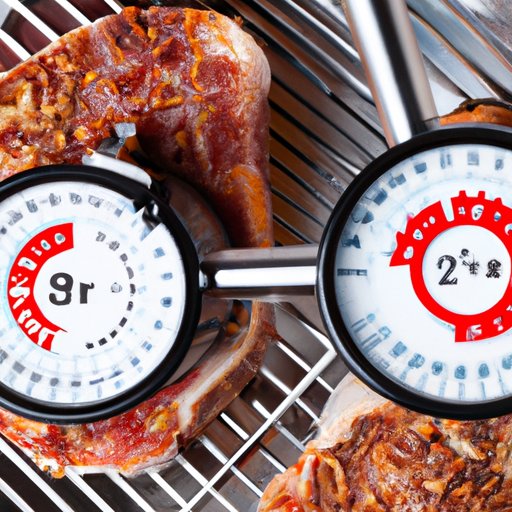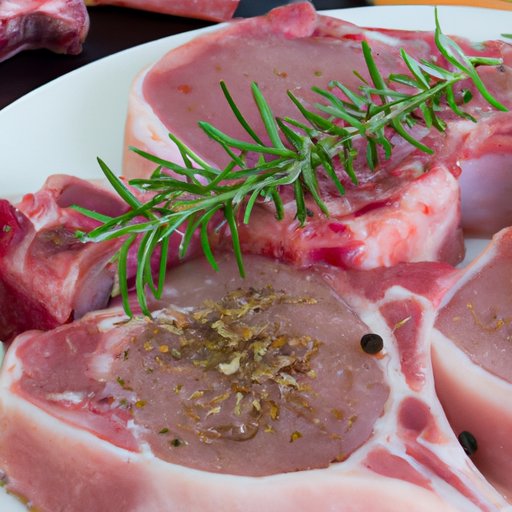
The Ultimate Guide to Making the Perfectly Tender Pork Chops: Tips and Techniques
If you’ve ever had a dry, tough pork chop, you know how important it is to get it right. Pork chops can be a flavorful, juicy addition to any meal, but they require some knowledge and technique to cook tender and moist. In this article, we’ll cover everything you need to know to make perfectly succulent pork chops every time.
Choosing the Right Cut of Pork
One of the keys to tender pork chops is starting with the right cut of meat. If you want juicy pork chops, look for ones that have a good amount of marbling, or fat marbled throughout the meat. Avoid lean cuts like tenderloin or sirloin, which can easily become tough and dry when cooked.
Brining and Marinating
Another technique for ensuring tender pork chops is to brine or marinate them before cooking. Brining involves soaking the meat in a saltwater solution, which helps to both season and tenderize the meat. Marinating works similarly, but with the addition of acid like vinegar or citrus, which also helps to break down the muscle fibers and tenderize the meat.
Proper Seasoning
A well-seasoned pork chop can be the difference between bland and delicious. Pork pairs well with a variety of spices and herbs, so don’t be afraid to get creative. However, it’s essential to season the meat before cooking to allow time for the flavors to penetrate the meat. Salt and pepper are always a good starting point, but don’t stop there. Try adding garlic, thyme, rosemary, or even a bit of brown sugar for a hint of sweetness.
Cooking Methods and Temperatures
The way in which you cook pork chops can also significantly affect their tenderness. Many methods, like baking or boiling, can result in tough, dry meat. Instead, try grilling, pan-searing, or broiling your chops. These methods produce a beautiful char and seal in the flavors and juices. Additionally, be mindful of the temperature you’re cooking your pork to. Overcooking pork is a surefire way to end up with dry meat.

Secrets to Perfectly Juicy Pork Chops
If you’re looking for juicy, perfectly tender pork chops, here are some top-secret techniques to achieving just that:
Dry-Brining Technique
Dry-brining is a process of seasoning the meat with salt and then letting it sit uncovered in the refrigerator for a few hours to overnight. This technique allows the salt to flavor the meat, but it also draws out moisture from the meat, which then gets reabsorbed, resulting in ultra-juicy pork chops.
High-Temperature Searing
Another way to obtain a flavorful crust on your pork chops without overcooking them is to sear them over high heat before finishing them in the oven or grill. This searing technique helps to lock in the juices and results in a beautiful crust on the outside of the chop.
Resting Period
Never underestimate the power of letting your pork chops rest after cooking. Resting allows the juices to redistribute throughout the meat and makes for a more tender and juicy final product. Let your chops rest for at least five minutes under a tent of aluminum foil before serving.
Using a Meat Thermometer
Using a meat thermometer is essential when cooking pork chops. Overcooking pork chops can result in dry, tough meat, while undercooking can lead to foodborne illnesses. The pork chops’ internal temperature should be 145°F (63°C) before serving.
Achieving Tender Pork Chops Without Dryness: A Step-by-Step Recipe
Ingredients:
- 4 bone-in pork chops (about 1 inch thick)
- 1 tablespoon of kosher salt
- 1 teaspoon of smoked paprika
- 1/2 teaspoon of garlic powder
- 1/4 teaspoon of black pepper
- 2 tablespoons of olive oil
Preparation Steps:
- Pat the pork chops dry with a paper towel.
- In a small bowl, mix together the salt, smoked paprika, garlic powder, and black pepper.
- Rub the spice mixture over both sides of the pork chops and refrigerate for at least one hour or overnight.
- Remove the pork chops from the refrigerator and let sit at room temperature for 30 minutes.
Cooking Instructions:
- Preheat the oven to 400°F (200°C).
- Heat the olive oil in an oven-safe skillet over medium-high heat.
- Once the pan is hot, place the pork chops in the skillet and cook for 3-4 minutes on each side, until nicely browned.
- Transfer the skillet to the oven and cook for an additional 6-8 minutes, or until the pork chops reach an internal temperature of 145°F (63°C).
- Remove the skillet from the oven and let the pork chops rest for at least 5 minutes.
Serving Suggestions:
Consider serving these juicy pork chops with a side of roasted vegetables or a simple salad for a healthy and satisfying meal.
Expert Advice: How to Cook Pork Chops That Are Moist and Tender
Tips from Professional Chefs:
“The secret to moist pork chops is a quick brine with a bit of sugar and salt. This process allows the meat to absorb more moisture, giving it a more substantial and juicier texture. Additionally, using a thermometer is key to avoid overcooking. As soon as the chops reach 145°F, take them out of the oven or off the grill and let them rest for a few minutes before serving.” – Chef Anna
Common Mistakes to Avoid:
- Overcooking the pork chops
- Skipping the resting period after cooking
- Underseasoning the meat
- Using the wrong cut of meat
- Not using a meat thermometer to check doneness
Creative Flavor Combinations:
Consider trying out different flavors and seasonings to spice up your pork chops. Here are a few ideas for inspiration:
- Maple syrup and Dijon mustard glaze
- Caramelized apple and onion sauce
- Ginger and soy sauce marinade
- Honey and balsamic vinegar reduction
The Science of Cooking Tender Pork Chops: Understanding Temperature & Resting Period
How Temperature Affects Meat Texture
Cooking meat to the correct temperature is essential for tender and juicy pork chops. As the temperature of the meat increases, the muscle fibers in the pork shrink and firm up, resulting in dry, tough meat. Cooking pork to an internal temperature of 145°F (63°C) ensures that the meat is cooked through while still being tender and juicy.
Importance of Letting Meat Rest
Another factor that affects the tenderness of meat is the resting period. Once the meat is removed from the heat source, it’s crucial to let it rest for a few minutes. During this time, the juices in the meat return to the center of the chop and are redistributed throughout, making for a more flavorful and tender meat.
Recommended Internal Temperatures for Pork
- Pork Chops: 145°F (63°C)
- Pork Tenderloin: 145°F (63°C)
- Pork Shoulder: 190°F (88°C)
- Pork Ribs: 160°F (71°C)
Quick and Easy Tips for Preparing Tender Pork Chops
When you’re short on time or budget, there are still many ways to make mouth-watering pork chops. Here are some quick and easy tips to try out:
Time-Saving Cooking Methods:
- Grill your pork chops for a smoky, charred flavor
- Sauté your pork chops in a skillet for a quick and easy meal
- Cook your pork chops in a slow cooker for a hands-off approach
Budget-Friendly Cut Options:
- Bone-in pork chops are typically less expensive than boneless options
- Pork shoulder or butt can be used in place of pork chops for a more affordable option
Flavorful Seasoning Alternatives:
- Herbs and spices like thyme, rosemary, or fennel can add depth of flavor to your pork chops
- A tangy BBQ sauce or a honey mustard glaze can elevate the flavor of your pork chops
- Fruit salsas like mango or pineapple can add a fresh and bright taste to your pork chops
5 Mistakes to Avoid When Making Tender Pork Chops
To get the most out of your pork chops, be sure to avoid these common mistakes:
Overcooking
Overcooked pork chops are tough and dry, so use a meat thermometer to ensure the meat is cooked to 145°F (63°C).
Underseasoning
Pork chops need to be well-seasoned to be flavorful, so don’t be afraid to experiment with different spices and herbs.
Using the Wrong Cooking Technique
Some cooking methods, such as boiling or baking, can quickly lead to dry pork chops. Opt for grilling, searing, or broiling to achieve a flavorful crust and juicy center.
Skipping the Resting Period
After cooking your pork chops, be sure to let them rest for at least five minutes. This resting period allows the juices to redistribute throughout the meat, making it more tender and flavorful.
Choosing the Wrong Cut of Pork
Lean cuts like tenderloin or sirloin can easily become dry and tough, so opt for a fattier cut like pork chops or shoulder.
Conclusion
Cooking tender, juicy pork chops is easy once you know the techniques and tips for doing so. By choosing the right cut of meat, properly seasoning and cooking your pork, and understanding the science behind temperature and resting periods, you can make delicious pork chops every time. Experiment with different flavors and approaches and find what works best for you.





